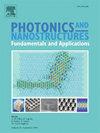高数值孔径圆柱矢量光束超构透镜设计的深度学习辅助聚焦工程
IF 2.9
3区 物理与天体物理
Q3 MATERIALS SCIENCE, MULTIDISCIPLINARY
Photonics and Nanostructures-Fundamentals and Applications
Pub Date : 2025-05-15
DOI:10.1016/j.photonics.2025.101396
引用次数: 0
摘要
与传统的优化算法相比,深度学习在解决涉及三维焦场定制的多维设计参数的复杂问题方面具有显著优势。本文提出了一种结合Richards-Wolf矢量衍射理论和神经网络技术实现不同焦场定制的设计方法。我们利用物理连接神经网络(PCNN)设计了一个25环的离散滤波器,用于指导全介电超构透镜的结构,从而促进了光针、光管和扩展焦深(>10λ)的平顶光场的反设计。结果表明,当与物理模型相结合时,神经网络可以有效地适应不同的设计目标,降低设计复杂性,提高设计过程的效率。本文章由计算机程序翻译,如有差异,请以英文原文为准。
Deep learning-assisted focus engineering for metalens design with high numerical aperture cylindrical vector beams
Deep learning, in comparison to traditional optimization algorithms, offers significant advantages in addressing complex problems involving multi-dimensional design parameters for the customization of three-dimensional focal fields. In this paper, we present a design method that combines Richards-Wolf vector diffraction theory and neural network techniques for achieving the customization of different focal fields. We utilize a Physics-Connected Neural Network (PCNN) to devise a discrete filter with 25 rings for guiding the structure of the all-dielectric metalens, thereby facilitating the inverse design of optical needles, optical tubes, and flat-top light fields with an extended focal depth (>10λ). The results demonstrate that when combined with a physical model, the neural network effectively adapts to diverse design objectives, reduces design complexity, and improves the efficiency of the design process.
求助全文
通过发布文献求助,成功后即可免费获取论文全文。
去求助
来源期刊
CiteScore
5.00
自引率
3.70%
发文量
77
审稿时长
62 days
期刊介绍:
This journal establishes a dedicated channel for physicists, material scientists, chemists, engineers and computer scientists who are interested in photonics and nanostructures, and especially in research related to photonic crystals, photonic band gaps and metamaterials. The Journal sheds light on the latest developments in this growing field of science that will see the emergence of faster telecommunications and ultimately computers that use light instead of electrons to connect components.

 求助内容:
求助内容: 应助结果提醒方式:
应助结果提醒方式:


